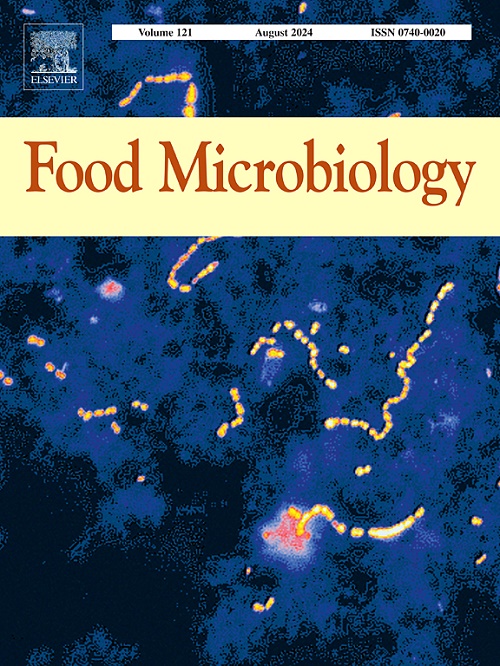Molecular characterization of emerging multi-drug resistant Clostridium perfringens isolated from pork production chains in Korea
IF 4.5
1区 农林科学
Q1 BIOTECHNOLOGY & APPLIED MICROBIOLOGY
引用次数: 0
Abstract
Clostridium perfringens is a common cause of foodborne illnesses and is involved in human and animal gastrointestinal diseases. Surveillance of C. perfringens in the pork production chain is crucial to manage the risk of pathogen transmission. This study aimed to investigate the prevalence, antimicrobial resistance profile, and genomic characteristics of C. perfringens in pork production chains in Korea. The overall prevalence of C. perfringens was 23.6% (330/1397), with 48.8 (178/365), 16.6 (138/832), and 7.0% (14/200) in pig farms, slaughterhouses, and retail markets, respectively. Toxinotyping revealed 98.9% type A and 1.1% type C isolates. Among them, 29.1% carried the beta-2 toxin gene. Antimicrobial susceptibility tests identified 20 multi-drug resistant isolates, with the highest resistance against tetracycline (65.1%). Whole-genome sequencing further revealed 17 antimicrobial resistance and 12 virulence genes. Subsequent phylogenetic analysis identified three clonal clusters, two of which revealed a clonal relationship with human clinical isolates reported in China. The ST408 isolate from the retail pork meat, IJCP45, harboured the optrA gene in a plasmid and was identical to known optrA-carrying plasmids in C. perfringens from livestock in China, suggesting the introduction and dissemination of optrA by the transmission of a specific plasmid in east Asian countries. To our knowledge, this is the first comprehensive study of C. perfringens in the pork meat production system as an “One Health” approach. The study findings provide baseline data for the distribution and genetic characteristics of pig-associated C. perfringens in Korea and indicate the zoonotic transmission potential of C. perfringens from pigs to humans.
从韩国猪肉生产链中分离的新出现的多重耐药产气荚膜梭菌的分子特征
产气荚膜梭菌是食源性疾病的常见病因,与人类和动物的胃肠道疾病有关。监测猪肉生产链中的产气荚膜梭菌对控制病原体传播风险至关重要。本研究旨在调查韩国猪肉生产链中产气荚膜荚膜杆菌的流行情况、耐药性特征和基因组特征。养猪场、屠宰场和零售市场产气荚膜荚膜杆菌总感染率分别为48.8%(178/365)、16.6%(138/832)和7.0%(14/200)。毒素分型显示98.9%为A型,1.1%为C型。其中,29.1%携带β -2毒素基因。药敏试验鉴定出20株多重耐药菌株,其中对四环素的耐药性最高(65.1%)。全基因组测序进一步发现17个耐药基因和12个毒力基因。随后的系统发育分析鉴定出三个克隆聚类,其中两个与中国报告的人类临床分离株存在克隆关系。从零售猪肉中分离出的ST408分离物IJCP45在一个质粒中携带optrA基因,与中国产气荚膜荚膜杆菌中已知的携带optrA基因的质粒相同,表明optrA是通过一种特定质粒在东亚国家传播的。据我们所知,这是首次在猪肉生产系统中采用“同一个健康”方法对产气荚膜杆菌进行全面研究。研究结果为韩国猪相关产气荚膜梭菌的分布和遗传特征提供了基线数据,并表明产气荚膜梭菌从猪到人的人畜共患传播潜力。
本文章由计算机程序翻译,如有差异,请以英文原文为准。
求助全文
约1分钟内获得全文
求助全文
来源期刊

Food microbiology
工程技术-生物工程与应用微生物
CiteScore
11.30
自引率
3.80%
发文量
179
审稿时长
44 days
期刊介绍:
Food Microbiology publishes original research articles, short communications, review papers, letters, news items and book reviews dealing with all aspects of the microbiology of foods. The editors aim to publish manuscripts of the highest quality which are both relevant and applicable to the broad field covered by the journal. Studies must be novel, have a clear connection to food microbiology, and be of general interest to the international community of food microbiologists. The editors make every effort to ensure rapid and fair reviews, resulting in timely publication of accepted manuscripts.
 求助内容:
求助内容: 应助结果提醒方式:
应助结果提醒方式:


